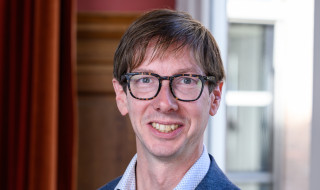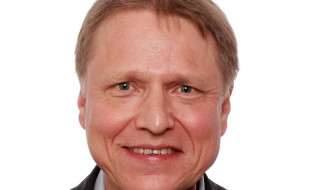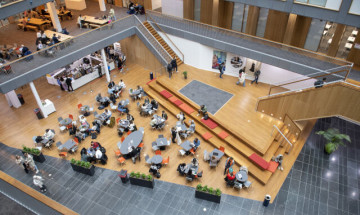The foundation of digital transformation: architecture
The digital transformation is moving forward fast, triggering major changes. Also in education and research, within institutions as well as nationally and increasingly at a European level. How do we stay in control? We talk to three experts about this. “I think we live in a great time.”
“The era when it was a question of whether technology could do something or not is behind us,” says Fontys director Hans Nederlof (in August 2023, Nederlof will transfer to The Hague University of Applied Sciences and join the board there). During his career as administrator and CIO/director IT in higher education, he has seen a lot of developments. “Nowadays, with it, just about anything is possible. What we need to address now are questions like ‘oh yes, this is possible, but do we want it? And if we want it, how do we want it?’. Indeed, that puts the parent questions where they belong, with administrators. I think we live in a great time.”

Hans Nederlof, member executive board Fontys
“In recent years, I have seen the administrative urgency on cooperation grow enormously. We now realise together, that we can only reach our ambitions if we act together. For example, if you talk about making education more flexible, you can't set that up variably at 50 different institutions for higher education. That would be a nonsensical task.”
But what to do now that institutions have their own landscape of information systems and a landscape of national information systems is into effect?
It starts with understanding and structuring information provision and it. And, from there, making agreements together towards a common dot on the horizon, registering it and being committed to it. We call this architecture.
“Architecture, in general, is a way to build entire landscapes more efficiently and coherently,” says Pekka Kähkipuro, CIO at Tampere University and Tampere University of Applied Sciences in Tampere, one of the larger Finnish cities after Helsinki. He has extensive expertise in architecture and experience as CIO in both the Nordics and the UK. “It's like a city plan. With an architecture, you guarantee that everything works better together.”
Better sector facilities
“Education and research use shared facilities, and this is only going to increase. As a sector, we want to develop better sector facilities together, well connected in an ecosystem. That is the goal,” says Jan-Willem Brock, CIO at Leiden University and as CSC pioneer linking pin around the topic of architecture. “Architecture, to that end, is the tool we use to achieve that goal.” Better sector facilities, in conjunction with each other, in turn contribute to the sector ambitions of making education more flexible, lifelong learning, open science and interdisciplinary collaboration in research.
“Architecture, in general, is a way to build entire landscapes more efficiently and coherently.”
Nederlof recognises the possibilities “Now, with architecture, we have found a way to have the discussion at the right level with each other. There is often an emotional side to major developments, such as a kind of not invented here.”
It is precisely with architecture that it is possible to take out that emotion and objectify the conversation.
We are all becoming increasingly dependent on digital technology, and are also putting it much more into all aspects of education and research. Coupled with that, the need for interoperability of this is growing. “It is no coincidence that we borrowed the word architecture from construction,” says Brock. “After all, just like buildings and cities, digital structures also need a good foundation to stay upright and function.”
Imagine a city in which residential areas develop, industry grows and sports fields are built, how traffic flows optimally through the city, which parts have a protected cityscape etc.
Being able to support both
For institutions, looking ahead is important: How do we want education and research to develop in the changing world? If we can imagine this better, we can also make better decisions about the information systems that should support this in the future. Architecture is an important tool here.

Jan-Willem Brock, CIO Leiden University
“In research, at its core it is very specialised work done by individual researchers. They exchange knowledge with peers and have good agreements about it, often worldwide,” says Brock. “Think of an astronomer here in the Netherlands and one in Australia, or two archaeologists on different continents. They speak each other's language and don't need architecture. But what if there is data exchange between astronomers and archaeologists? We then see that architecture is needed for that. This is an example of an extreme, but you also see it within an institution. Think of data storage or archiving for social sciences and life sciences. Across those two domains, you have generic facilities.”
Kähkipuro: “In Finland, the short-term vision is there, but the longer-term vision will depend on the development of the whole sector. For example, we see in Finland that microcredentials are becoming more and more important. People collect elements relevant to their future careers. They come from different institutions and are each used to their own style and form. This development is changing the way institutes offer their curriculum and content. Students will soon create their careers in a completely different way. These are changes that are coming. We can continue as we are used to now, but for long-term outcomes, we need to be prepared.”
What is sector architecture? And which ones do we know in education and research?
Higher education, sector partners and SURF have jointly developed domain architectures for common sector facilities within higher education in the Higher Education Sector Architecture (HOSA) project. The management and further development of HOSA has been entrusted to SURF. This sector architecture contains frameworks and requirements that help suppliers of the common information and technology facilities develop and deliver these facilities. Central to this is the coherence and balance between the different needs of the various stakeholders in the sector such as students, citizens, institutions and sector partners.
At the level of institutions, there is the HORA, which is the Higher Education Reference Architecture and consists of a collection of instruments for setting up the organisation and information management within a Dutch higher education institution.
MBO also works with architecture. MORA is the reference architecture for secondary vocational education (MBO), and at the sector level, work is being done on MOSA, Medium Vocational Education Sector Architecture.
“The structure we established using sector architecture is reflected in the implementation programme.”
“Student mobility is increasing, yet there will always remain a large group of students for whom this does not apply. Who don't need flexible education and just want to know in advance what the curriculum will look like for the next four years. At least, that's what you see in higher education. Then you come back to the core: the future architecture must be able to support both,” says Nederlof. The question is then whether the principles on which the current systems are based still fit with the systems we need to support flexibilisation.
Commitment to the frameworks
SURF and its members have been working on architecture issues for decades. Yet, the subject is only now starting to get wider attention. That is, in part, because of the focus on it in the National Growth Fund application. “Together, we put a lot of work into HOSA, the Higher Education Sector Architecture project, in which frameworks were worked out. These were adopted in the National Growth Fund application for NPuls,” says Brock. “The structure we established using sector architecture is reflected in the implementation programme.”
“Innovation can only be achieved if you can start from space and trust. Together, you also have to have some nerve.”
While at the national level architecture in secondary and higher education is receiving attention through the growth fund programme Npuls, Finland has a similar initiative: Digivisio. “When we started Digivisio, we found that there was a lack of strategy within the bigger picture. As it turns out, we don't have a national solution in which every institution can participate,” says Kähkipuro. “We thought we had enough elements, but it soon became clear that we still have a lot to do for student administration, for example, and one step further, for identity management.”
Starting from space and trust
“Innovation can only be achieved if you can start from space and trust. Together, you also have to have some nerve,” says Nederlof. “That also requires risk appetite and it means that if things don't go well, you have to be able to say to each other ‘we did our very best for this, but it didn't turn out as we had hoped or thought.’ Sometimes, in larger pilots or experiments, you can run into the fact that the basic principles in the architecture are not satisfactory. You should be able to discuss that, there should be that space, as long as you do it in consultation and can explain it.”
For the Netherlands, the maturity level on this subject differs per institution. “It means that we also have to help smaller institutions, which are often not as far advanced, move forward from the collective,” says Brock. To this end, we are working with fellow institutions and SURF on an update for the HORA. The institutions themselves can use this as a reference for their own landscape of processes and systems.

Pekka Kähkipuro, CIO Tampere University & University of Applied Sciences (Finland)
Kähkipuro: “In a way, it is very funny, there is always a quick fix possible. But when you work with too many quick fixes, the whole thing becomes unstable, and that's not what we want. In Finland, we are working to understand where quick fixes have arisen in the past and how to build solid solutions for them along other principles. This is necessary to be sustainable and future-proof.”
Architecture in Europe
With his international experience as CIO in both the Nordics and the UK, Kähkipuro has a broad view of several developments within Europe. “In Sweden, for example, all institutions use the same tool for student record management. So they do not have to compete with each other in this area, which gives them a more competitive position in the world. In contrast, the UK has a very different educational landscape that is more commercial; where you pay very high tuition fees for some institutions, so the landscape there will always be more heterogeneous.”
Finland and the Netherlands are both well into their digital maturity. The Netherlands perhaps even a little further. Kähkipuro: “The HOSA works and has been developed from the institutions as a national architecture for the Netherlands. For Finland, we can borrow elements from it and may need to set up something similar. The same applies to other countries. At the same time, we are also looking one level higher, at European requirements.”
“For the European level, we can analyse the national architectures and see what elements from that we can adopt into a European architecture."
“Europe is becoming increasingly important, also in subsidy issues,” says Brock. “You see the world getting smaller and smaller. Cooperation is no longer local or national, it is international. Many of our students also study abroad, and our astronomers collaborate more with astronomers abroad than with their fellow social science researchers within the university.”
“For the European level, we can analyse the national architectures and see what elements from that we can adopt into a European architecture, so that it grows out of the national approaches. And vice versa,” says Kähkipuro.
Catching up on a lead
But what if a country is suddenly way ahead with its own architecture independent of Europe and other European countries? In such a situation, according to Kähkipuro, constant evaluation is needed. “When you are on top of developments and you are apparently doing better than others, you should probably continue your work. But when the others are catching up and you get more together again, it is good to take the leap to the joint train. In a way, this is what also happened around GDPR. Germany was way ahead and little by little the other countries caught up until the moment Germany rejoined the rest. Now we have a solid European solution for data privacy.” He can imagine a similar development for a European sector architecture.
"How can, and do we want, to work together? We built the HOSA architecture for the national sector facilities that is now in place together."
Doing the right things, right
Architecture helps to make good decisions. Brock: “Are we doing the right things, and are we doing things right.” The questions we ask ourselves are: what is the same at every institution now? Where is there overlap and what are the differences? How can, and do we want, to work together? We built the HOSA architecture for the national sector facilities that is now in place together. It has come about through cooperation with many institutions, but certainly also with many chain partners with whom we have sought coordination to ensure that the architecture complies.
“Discussions about architecture are quite complicated within an institution,” says Nederlof, “But at the very other end of the spectrum, in the Information Room (the administrative consultation between the education sectors, DUO, SURF and OCW), the same applies. There we have all directors who are not trained as architects either, and we have a challenge with each other; ‘do we understand it all and do we oversee it right?’. I notice it myself every time, ‘my goodness, how complex that matter is’."
Text: Maureen van Althuis
'The foundation of digital transformation: architecture' is a SURF Magazine article.
Back to SURF Magazine
If you have any questions regarding this article, please, send us an email: magazine@surf.nl.
